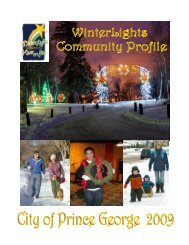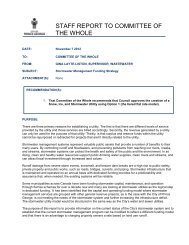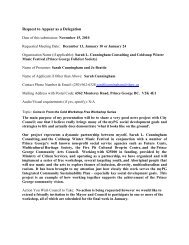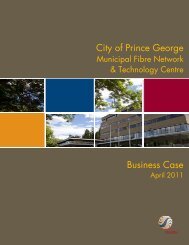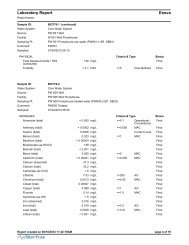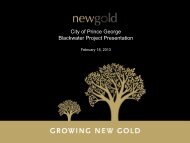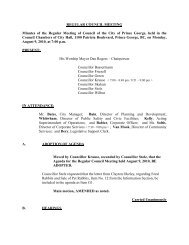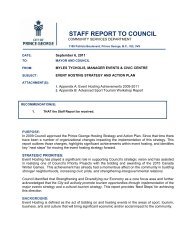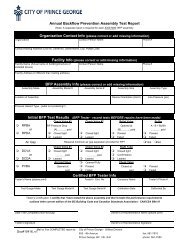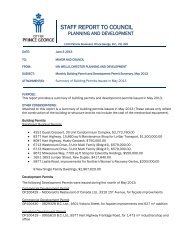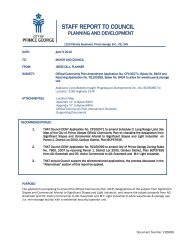Carney Hill Neighbourhood Centre Project - City of Prince George
Carney Hill Neighbourhood Centre Project - City of Prince George
Carney Hill Neighbourhood Centre Project - City of Prince George
Create successful ePaper yourself
Turn your PDF publications into a flip-book with our unique Google optimized e-Paper software.
STAFF REPORT TO COUNCILTO: MAYOR AND COUNCILDATE: March 23, 2010TO:FROM:SUBJECT:Mayor and CouncilChris Bone, Social Policy Facilitator<strong>Carney</strong> <strong>Hill</strong> <strong>Neighbourhood</strong> <strong>Centre</strong> <strong>Project</strong>ATTACHMENT: March 2010 <strong>Carney</strong> <strong>Hill</strong> Neighborhood <strong>Centre</strong> <strong>Project</strong> UpdateRECOMMENDATION:1. That the staff report and March 2010 <strong>Carney</strong> <strong>Hill</strong> <strong>Neighbourhood</strong> <strong>Centre</strong> <strong>Project</strong> Update(attached) be received.PURPOSE:The purpose <strong>of</strong> this information report is to update Council concerning administrative discussionwhich is occurring between the <strong>City</strong> and the <strong>Carney</strong> <strong>Hill</strong> <strong>Neighbourhood</strong> <strong>Centre</strong> Society(CHNCS) and describe the next steps in that process.Council has previously received various administrative reports and a Neighborhood <strong>Centre</strong>Feasibility Study by Yates, Thorn and Associates.CHNCS has recently advised that they consider the feasibility study recommendations to beunrealistic and would prefer instead, to approach the matter differently.Administration will be working with the CHNCS to identify and evaluate siting options concerningthe proposed neighbourhood centre and return that information to Council for consideration.STRATEGIC PRIORITES:This matter relates to several focus areas identified in the <strong>City</strong>’s Strategic Plan including:• building stronger neighborhoods;• improving our health and safety; and• an inclusive community.
POLICY / REGULATORY ANALYSIS:No policies or regulations are affected at this time.The siting evaluation work will consider Official Community Plan, zoning and environmentalpolicies <strong>of</strong> the <strong>City</strong>. Results will be reported to Council at future meeting.FINANCIAL CONSIDERATIONS:This project is not included in the <strong>City</strong>’s current financial plan.Capital and operating funds for the proposed neighbourhood centre would be raised from noncitysources under the CHNCS concept.SUMMARY AND CONCLUSION:It is well known by social service providers, government agencies and departments, the RCMPand by the neighbourhood residents themselves that this area experiences high rates <strong>of</strong>negative social outcomes. The CHNS has been working for the past 16 years to meet the socialneeds <strong>of</strong> residents living in the neighbourhood and has established the creation <strong>of</strong> aneighbourhood centre as a key goal.We are advised that the Society is <strong>of</strong> the view that the 2008 <strong>Carney</strong> <strong>Hill</strong> <strong>Neighbourhood</strong> <strong>Centre</strong>Feasibility Study which addressed the feasibility <strong>of</strong> the <strong>City</strong> taking on the development,implementation and operation <strong>of</strong> a neighbourhood centre, to be unrealistic. Instead, they haveproposed that the CHNCS take responsibility for the development, implementation andoperation <strong>of</strong> a proposed neighbourhood centre and Administration will be assisting the Societyto evaluate siting options.Respectfully submitted,Chris BoneSocial Policy Facilitator2
March 2010MARCH 2010 CARNEY HILL NEIGHBOURHOOD CENTRE PROJECT UPDATEProvided by: <strong>Carney</strong> <strong>Hill</strong> <strong>Neighbourhood</strong> <strong>Centre</strong> SocietyThe <strong>Carney</strong> <strong>Hill</strong> <strong>Neighbourhood</strong> includes about 2000 residences and has a population <strong>of</strong> approximately4000. This area has a very high percentage <strong>of</strong> young First Nations families (under the age <strong>of</strong> 25).<strong>Carney</strong> <strong>Hill</strong> <strong>Neighbourhood</strong> <strong>Centre</strong> Society has been working for the past 16 years (see Appendix A) tomeet the social needs <strong>of</strong> residents living in the neighbourhood previously known as the VLA (VeteransLand Act). A key component <strong>of</strong> the CHNCS vision has been to create a neighbourhood centre for localresidents. This document summarizes background data in support <strong>of</strong> this vision.<strong>Carney</strong> <strong>Hill</strong> <strong>Neighbourhood</strong> Socio‐Economic RealityIt is well known by social service providers, government agencies and departments, the RCMP and bythe neighbourhood residents themselves that this area experiences high rates <strong>of</strong> negative socialoutcomes. For example:‣ The neighbourhood is one <strong>of</strong> the poorest in <strong>Prince</strong> <strong>George</strong>. Parent average income wasreported to be $25900 annually 1 . This is the lowest parent income for any school catchmentarea in <strong>Prince</strong> <strong>George</strong>, where only two other schools have average parent incomes <strong>of</strong> under$50,000.‣ This neighbourhood has more children in care that any other neighbourhood in <strong>Prince</strong> <strong>George</strong>.‣ The neighbourhood is ranked as the highest risk neighbourhood in the Province <strong>of</strong> British Columbia forhealthy child development. Up to 45% <strong>of</strong> the neighbourhood children were not meeting physical healthand well‐being needs, up to 25% <strong>of</strong> children scored in the significant range for language and socialcompetency vulnerability and up to 36% <strong>of</strong> children were vulnerable in communication skills 2‣ School performance was ranked last (876th out <strong>of</strong> 876) according to the Fraser Institute Reportfor 2009. Furthermore, this report notes that 17% <strong>of</strong> the students are designated special needs.This is the highest percentage <strong>of</strong> special needs children <strong>of</strong> any school in <strong>Prince</strong> <strong>George</strong> and issignificantly greater than most other schools (where rates <strong>of</strong> roughly 2% ‐ 6% are more likely tobe found).‣ It has the highest crime rate <strong>of</strong> any other neighbourhood in <strong>Prince</strong> <strong>George</strong>‣ The residents <strong>of</strong> this neighbourhood have significant health issues including a high population <strong>of</strong>individuals with mental health issues such as FASD, PTSD, generational traumas, “at risk”behaviors, addictions, acquired brain injuries and so on.The issues are clear; poverty, high unemployment, children at risk, children with disabilities, high crimerates, and significant health/mental health issues exist across the population.<strong>Carney</strong> <strong>Hill</strong> Socio‐Economic Issues and the Broader <strong>Prince</strong> <strong>George</strong> CommunityOver 1000 male and female parolees are served every year through provincial bail and probationservices in <strong>Prince</strong> <strong>George</strong>. Over half <strong>of</strong> these people transition from jail into the <strong>Carney</strong> <strong>Hill</strong>neighbourhood. Back‐to‐the‐community transition services are very limited everywhere, including in<strong>Carney</strong> <strong>Hill</strong>. The result is that a large, high risk (risk <strong>of</strong> re‐<strong>of</strong>fending) population exists in <strong>Carney</strong> <strong>Hill</strong> andit is putting both the neighbourhood (as evidenced by the high crime rate) and the broader community<strong>of</strong> <strong>Prince</strong> <strong>George</strong> at risk <strong>of</strong> further criminal victimization. Many <strong>of</strong> the downtown social problems canbe directly linked to this aspect <strong>of</strong> the <strong>Carney</strong> <strong>Hill</strong> neighbourhood.1 Fraser Institute 2008/09 report2 (Hertzman et al., 2002, p.10)1
March 2010 A building will facilitate the provision <strong>of</strong> focused back‐to‐the‐community transition supports forparolees. A meaningful, neighbourhood‐based approach to healthy lifestyle choices can be developed. It will provide opportunities for education and learning and will provide capacity for thedevelopment and delivery <strong>of</strong> employment and life skills training programs. It will provide a non‐institutional healing space for positive and meaningful social, cultural andrecreational activities.The neighbourhood centre will:‣ Enable local collaboration <strong>of</strong>, and for, the provision <strong>of</strong> needed social services‣ Facilitate greater ownership by the residents for the development and implementation <strong>of</strong> localsolutions to their social‐ and economic‐based problems.‣ Create resident‐driven and accessible cultural, recreational, social, educational andemployment‐ related opportunitiesThe <strong>Neighbourhood</strong> <strong>Centre</strong> will impact socio‐economic indicators by acting as a stepping stone forresidents who will use it to take the first steps needed to make the changes they desire in their lives. Byincreasing the ease with which services can be accessed and by increasing the capacity <strong>of</strong> service to beprovided within the neighbourhood culture residents will find success is more readily achieved andexperienced. And it is from these small successes that the bigger successes are ultimately built upon.Support for a <strong>Neighbourhood</strong> <strong>Centre</strong>Dozens <strong>of</strong> social service providers as well as government departments and agencies are mandated toaddress the social issues that exist in the <strong>Carney</strong> <strong>Hill</strong> neighbourhood. In 2009, the CHNCS CommunityDevelopment Coordinator connected with thirty‐eight <strong>of</strong> these (See Appendix B). Many have indicatedthat they recognize both the significant challenges their clients experience, and the challenges theyexperience trying to connect with and serve their clients. They acknowledge that providing services totheir respective clients ‘where they live’ would result in improved service delivery and moreimportantly, improved outcomes. They have indicated support for working collaborative to do this.Expected Impact <strong>of</strong> a <strong>Neighbourhood</strong> <strong>Centre</strong> on Socio‐Economic OutcomesIt is anticipated that by reducing barriers and increasing accessibility, residents will access the servicesthey need to make the positive changes they desire. Such changes will include, for example: Feelings <strong>of</strong> security when basic needs are met by providing streamlined service provision todirectly address food, clothing, and housing needs; Stronger family units when increased access to childcare/after school care with moreparent/child supports are in place to help address family based issues; Enhanced life skills when increased programming and assistance is readily available to improvethe health and well being <strong>of</strong> individuals and families; Improved health when more access is provided for addictions and/or mental health counseling; Increase public safety and reduced criminal activity not only in the immediate area but also inthe wider community as a result <strong>of</strong> these changes; Positive feelings <strong>of</strong> connection with others when the neighbourhood is safe and a local commonspace and environment is available for relaxing, fun and stimulating activities; Employment or more self‐sustained supported living situations when supports are pro‐activelyaccessed, upgrading is pursued or other education opportunities are accessed, and whenvolunteer and employment opportunities are generated through the <strong>Centre</strong> itself;3
March 2010 Increased positive engagements with the broader community <strong>of</strong> <strong>Prince</strong> <strong>George</strong> as a result <strong>of</strong>residents being supported to make these changes; Reduced costs as indirect revenues will be recovered with decreased health care costs; fewercalls for emergency response resources i.e. RCMP, Fire Department, and Ambulance and adecrease in outreach service provider burnout. Increased economic value to the neighbourhood as these longer‐term changes will reduce thedrain that negative social behavior has on the neighbourhood community as a whole and willgenerate direct revenues as a result <strong>of</strong> increased real estate values and growth in small businessdevelopment.4
March 2010KEY DATES: 1992 TO 2010Appendix A<strong>Carney</strong> <strong>Hill</strong> <strong>Neighbourhood</strong> <strong>Centre</strong> Society History in brief: 1992 – <strong>Carney</strong> <strong>Hill</strong> community rallied to create positive change 1994 – <strong>Carney</strong> <strong>Hill</strong> <strong>Neighbourhood</strong> <strong>Centre</strong> (non pr<strong>of</strong>it) Society incorporated 2004 ‐ Ideas for Change (UNBC School <strong>of</strong> Environmental Planning) – Business Plan Development 2004 ‐ Presentation to <strong>City</strong> Council where support was acknowledged 2006 ‐ Community Development Steering Committee formed 2007 – Community Development Coordinator position created 2007 ‐Actions for Change Workshop (SPARC, The Social Planning and Research Council <strong>of</strong> BC) 2007 – Presentation to <strong>City</strong> Council for land. Subsequently the <strong>City</strong> proposed and partiallyfunded the Feasibility Study. 2007 ‐ Feasibility Study Commissioned 2008 – Feasibility Study Completion 2008 – Feasibility Study presented to <strong>City</strong> Council 2009 – Service Needs Assessment Completion 2010 – Moving Forward5
March 2010Social Service Agencies and Government DepartmentsAppendix BSocial Service AgenciesAids Prevention ProgramAboriginal Business Development AssociationAboriginal Education Workers (School District #57)Association Advocating for Women and ChildrenActive Support Against Poverty (ASAP)Activity <strong>Centre</strong> for EmpowermentBrain Injured Group (BIG)British Columbia Housing Aboriginal Housing<strong>Carney</strong> <strong>Hill</strong> Elementary SchoolCarrier Sekani Family Services Soup BusCarrier Sekani Family Services (CSFS)CASEY (Communities Against Sexually Exploited Youth)Central Interior Native Health SocietyChild Care Resource and Referral (CCRR), operated by the YMCAChild Development <strong>Centre</strong> (CDC)Elizabeth Fry SocietyThe Fire PitFuture CentsKetso YohMilburn Community Gardens SocietyNorthern Family Health ServicesNorthern John Howard SocietyParent Support Services (PSS)Phoenix Transition House SocietyPrima Assessment <strong>Centre</strong><strong>Prince</strong> <strong>George</strong> Community Policing<strong>Prince</strong> <strong>George</strong> Crisis <strong>Centre</strong><strong>Prince</strong> <strong>George</strong> Drug and Alcohol Services<strong>Prince</strong> <strong>George</strong> Native Friendship <strong>Centre</strong><strong>Prince</strong> <strong>George</strong> Urban Aboriginal Justice Society<strong>Project</strong> Parent North (PPN)Queensway Community GardensRodicca HouseZechariah HouseGovernment DepartmentsCommunity Corrections (Adult Probation), Ministry <strong>of</strong> Public Safety and Solicitor GeneralCorrectional Service <strong>of</strong> Canada, <strong>Prince</strong> <strong>George</strong> Federal ParoleMinistry <strong>of</strong> Children and Families (MCFD)Ministry <strong>of</strong> Housing and Social Development6



